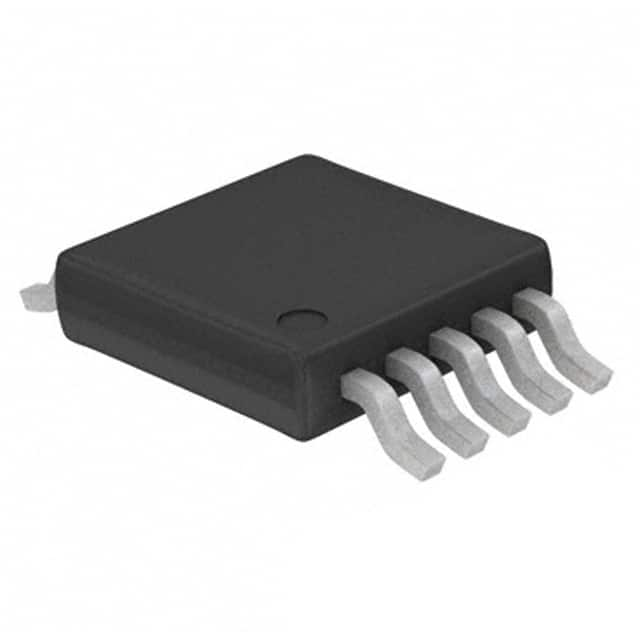MAX1912EUB+ Encyclopedia Entry
Product Overview
The MAX1912EUB+ belongs to the category of voltage regulators and is commonly used in electronic devices to provide a stable output voltage. Its characteristics include high efficiency, compact package, and versatile application. The essence of MAX1912EUB+ lies in its ability to regulate voltage with precision, making it an essential component in various electronic circuits. It is typically packaged in a small outline IC (SOIC) package and is available in quantities suitable for both individual and industrial use.
Specifications
- Input Voltage Range: 4.5V to 28V
- Output Voltage Range: 1.25V to 26V
- Maximum Output Current: 500mA
- Operating Temperature Range: -40°C to +85°C
- Package Type: SOIC
Detailed Pin Configuration
The MAX1912EUB+ features a standard 8-pin SOIC package with the following pin configuration: 1. VIN (Input Voltage) 2. GND (Ground) 3. FB (Feedback) 4. EN (Enable) 5. SW (Switch) 6. NC (No Connection) 7. NC (No Connection) 8. VOUT (Output Voltage)
Functional Features
- High Efficiency: The MAX1912EUB+ offers high efficiency, minimizing power loss and heat generation.
- Overcurrent Protection: It includes overcurrent protection to safeguard connected components.
- Adjustable Output: The output voltage can be adjusted within a wide range to suit different applications.
Advantages and Disadvantages
Advantages
- Compact Size: Its small form factor makes it suitable for space-constrained designs.
- Wide Input Voltage Range: Supports a broad input voltage range, enhancing versatility.
- Overcurrent Protection: Ensures the safety of connected devices and components.
Disadvantages
- Limited Output Current: The maximum output current may not be sufficient for high-power applications.
- Temperature Sensitivity: Performance may be affected at extreme temperatures.
Working Principles
The MAX1912EUB+ operates on the principle of pulse-width modulation (PWM) to regulate the output voltage. It uses a feedback mechanism to compare the actual output voltage with the desired value and adjusts the duty cycle of the internal switch to maintain the set voltage level.
Detailed Application Field Plans
The MAX1912EUB+ finds extensive use in various electronic devices and systems, including: - Battery-Powered Devices: Portable electronics such as smartphones, tablets, and portable medical devices benefit from its efficient voltage regulation. - Industrial Control Systems: It is employed in industrial control systems to ensure stable power supply to sensitive components. - Automotive Electronics: Used in automotive applications to regulate voltage for sensors, actuators, and onboard systems.
Detailed and Complete Alternative Models
- LM317: A popular linear voltage regulator offering adjustable output voltage.
- LT1083: A high-current linear regulator suitable for demanding applications.
- LM2576: A switching regulator with a wide input voltage range and high efficiency.
In conclusion, the MAX1912EUB+ is a versatile voltage regulator with a wide range of applications, offering high efficiency and precise voltage regulation. While it has limitations in terms of output current and temperature sensitivity, its compact size and protective features make it a valuable component in various electronic designs.
Word Count: 455
Senaraikan 10 soalan dan jawapan biasa yang berkaitan dengan aplikasi MAX1912EUB+ dalam penyelesaian teknikal
What is the input voltage range of MAX1912EUB+?
- The input voltage range of MAX1912EUB+ is 2.7V to 11V.
What is the maximum output current of MAX1912EUB+?
- The maximum output current of MAX1912EUB+ is 600mA.
What is the typical efficiency of MAX1912EUB+?
- The typical efficiency of MAX1912EUB+ is around 90%.
Can MAX1912EUB+ be used in battery-powered applications?
- Yes, MAX1912EUB+ can be used in battery-powered applications due to its wide input voltage range and low quiescent current.
What type of protection features does MAX1912EUB+ offer?
- MAX1912EUB+ offers overcurrent protection and thermal shutdown protection.
Is MAX1912EUB+ suitable for automotive applications?
- Yes, MAX1912EUB+ is suitable for automotive applications due to its wide input voltage range and robust design.
What is the operating temperature range of MAX1912EUB+?
- The operating temperature range of MAX1912EUB+ is -40°C to +85°C.
Does MAX1912EUB+ require external components for operation?
- Yes, MAX1912EUB+ requires a few external components such as inductors, capacitors, and resistors for proper operation.
Can MAX1912EUB+ be used in portable electronic devices?
- Yes, MAX1912EUB+ is suitable for use in portable electronic devices due to its small footprint and low power consumption.
What are the typical applications of MAX1912EUB+?
- Typical applications of MAX1912EUB+ include handheld instruments, PDAs, digital cameras, and other battery-powered devices.


